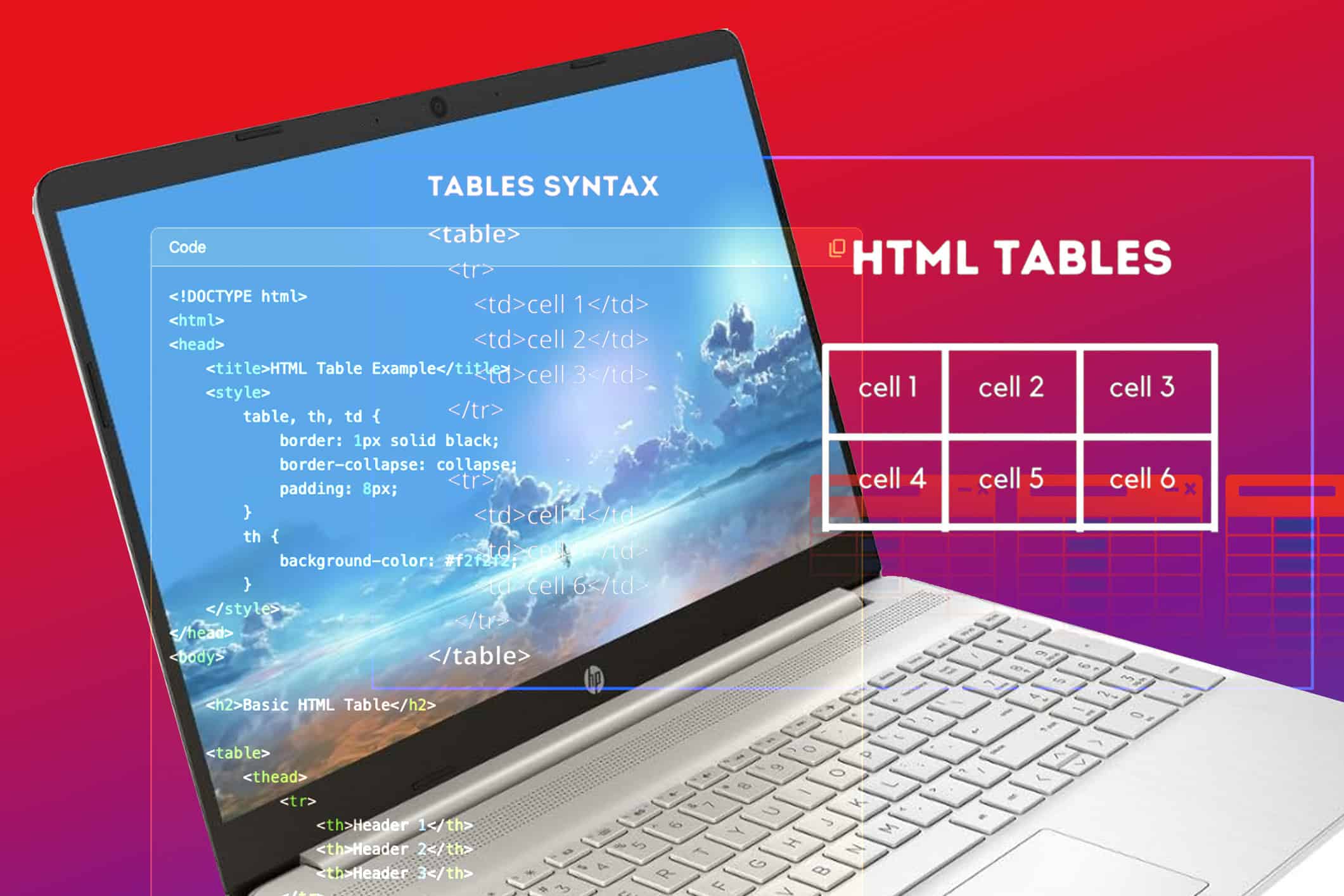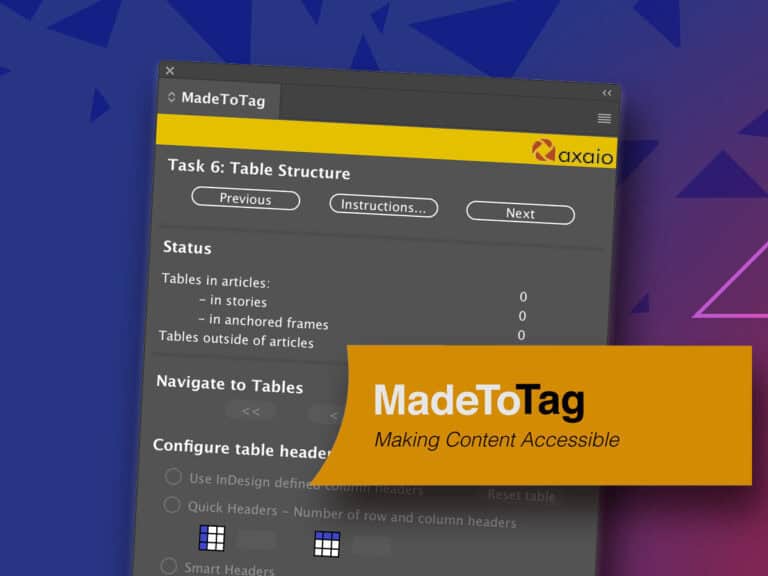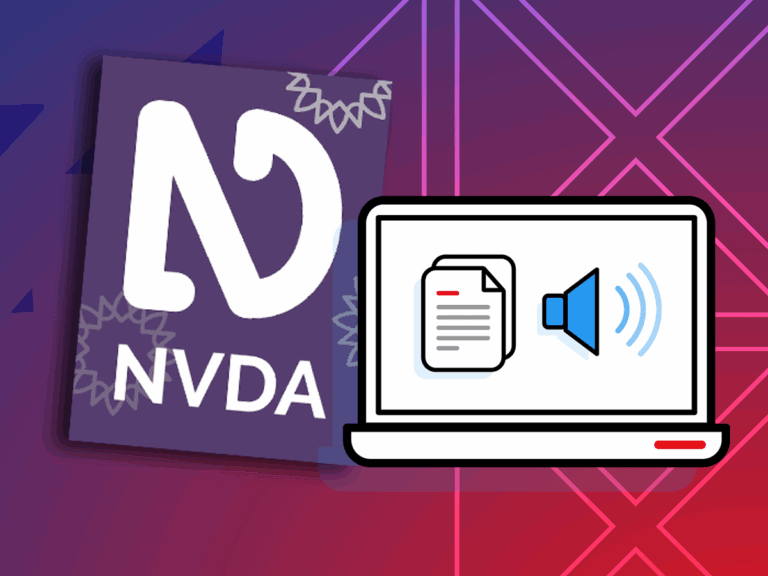Articles and Research

Advanced Table Remediation
What do you do when someone emails you a PDF full of tables with rows and rows of merge cells and says “Make this an accessible PDF, please?” Ask for the source of course. But what do you do when you can’t get the source? Well, watch this video to find the solution to one common problem with merged cell headings in tables created in MS Word. If you want to see more videos on other specific topics, leave a comment and who know? Maybe your question might be the source of the next video in the “Fix it Friday” series for PDF accessibility.
Video Content
All right guys, welcome to Fix It Friday and I’m Dax Castro. I’m here to help you tackle the tags tree and lead you down the road of remediation. So let’s dive right in. All right, so if we take a look at this table, we can see that all of the elements in this table have little blue squares around them. Now yours might be a different color than mine, but they should all have a little blue square or a little square around them, letting you know that all of the information in this table has a tag somewhere in the tags tree. If we go to our next page, we see we have an issue. Here we see that only part of the heading has squares around it, but the rest of the table does not. Let’s keep going. Well, it looks like we have the same issue here. We’re on page 25, 26, 27, 28, 29, 30, 31, 32, all the way down. Wait, what happened there? Oh, we went from page 37 to page 23, and look at it, there’s the rest of our content. Let’s make a note of that. So this is the rest of our table. So we’re gonna call this body for a second, right? And then we’re gonna go back up here.
That was the correct table, but this was the other half of this table. So let’s go ahead and take this table, and we’re gonna drag this on up here, and we’re gonna stick it right underneath this other table. Now look what happens here. We’re in the same table, But part of it’s being selected from this table and part of its being selected from that table. And that’s not what we want at all. So let’s take a deeper look here. So first we want to expand these two tags trees and we can see that this has a table body but no table heading. And this one has a table heading and a table body like we would normally expect. Right? So what do we need to do? We’re going to go ahead and expand this and we see we have a table row. And we expand this one. And here’s another table row. We need to get these both in the same place. So we’re going to go ahead and grab this. We’re going to left click on this table row here. And we’re going to drag it down underneath here.
Now we don’t want to be out here. We want to be underneath the tag so that it’s at the same level as the table row below it. And we let go. Right. And now we can see. that this table row and this table row are inside this table heading everything highlights blue we’re good to go so let’s go ahead and delete this other table since it’s empty now and we don’t need it so now we have everything in one unified table which pretty much means we’re gonna have to do that same process for each one of these tables but we’re not done yet alright so now we have to go ahead and make sure that all of our table rows have the right column span and merge cells right so let’s go ahead and look at this first table row and we can see we have table heading here and a table heading there Right? That looks pretty decent. And we’re going to go ahead now and we’re going to go into the accessibility tag.
If you don’t see this accessibility panel over here, you can click down here for more tools and then you can drag the accessibility panel from here over onto the side. But I already have it, so I don’t need to do that. So let’s go back to where we were. We’re going to use the read order tool. So we’re going to go ahead and select this table here. I always click on the number, but you can click pretty much anywhere as long as it turns blue. And then we go to table editor. And now we can see here I have my table headings marked as orange. Yours might be a different color. This is just what I’m used to. So I can see that this table heading is set correctly for at least these four things. But I’m missing my table headings down here. And it looks like we have some row headings. That need to be set as well so, let’s go ahead and take care of that first we’re gonna right click on this cell and we’re gonna go to cell properties and we’re gonna look at it we see it is a heading cell but it doesn’t have any scope now.
Normally it wouldn’t matter whether you have scope or not because as long as there’s a single row at the top NVDA and JAWS assume that it is a row heading now now of course we know tables should have heading cells so we want to go ahead and set those but the scope is assumed when it’s a regular table and there’s only a heading row on the top but since we have merge cells in this table we want it to sound correct so we need to set the scope so we’re gonna go ahead and set the scope for this one to column right and right now it says it only spans one column but we can definitely see This spans one, two, three, four columns. So we’re going to go ahead and set that. And the reason we want to set that is as someone moves through the table, we want JAWS or NVDA to know that this heading needs to be included when referencing any of the cells below it.
So that’s why we set the column span so we’re going to go ahead and set this to four because we can see that it spans these four columns so we’re going to go ahead and hit okay and you can see our little warning here that says hey do you really want to do this make sure you save your document at key points along the way because once you hit yes you’re stuck and you don’t want to have to do some surgery and replacing certain pages in a long document it’s always best to save all right so we’re going to go ahead and hit okay and now we can see our table heading is correct it spans the four columns and we’re good to go now let’s take a look at these now we’re going to hold down shift and we’re going to click on each one of these cells and we’re going to go to cell properties and we’re going to set the scope from none to column because they’re all column headings and none of them span more than one column so we’re good to go Alright, next we need to tackle these other ones here.
So we’re going to go ahead and click on this one, hold down shift, and click on this one, hold down shift, this one, this one, and this one. And we’re going to right click and go to cell properties. And again, now these need to be set to heading cells. And their scope is again column because they affect everything below them. And now we see what we need to set the column span because here these merge cells span the entire table. So how many cells do we have? One, two, three, four, five. We have five columns, so we’re going to go ahead and set that column span to five and hit OK. Yes, we want to go ahead and do this, and there we go. Now look, everything lines up.
We’re looking pretty good. All of our columns and rows seem to be all where we want them to be, but we’re missing a few things. Each of these cells here, holding down shift, we’re going to click on each one of these, and once we do, we’re going to right click We’re going to go to cell properties and we know these are heading cells and we’re going to set the scope to row because they affect everything to the right of it. They are row headers. We want JAWS and NVDA to voice these subcategories as someone is walking through this table reading all of this data. So we go ahead and hit OK. And there we go. So now we have appropriately set column rows and column headings And as JAWS walks through this table, it’s gonna know what references to use and which ones not.
This is a perfectly remediated table. Now we have to do this same process for all of these other tables within this entire document. All right, so that’s it. So I hope this gave you some information on how to remediate some tables when things don’t always work out as planned. When we’re merging cells inside Word, we convert to PDF. Sometimes it doesn’t always go the way we want it to. But most of the time, there’s a way to fix it. We just have to go step by step, make sure our scopes and columns and merge cells and everything are all in line, and you should come out OK. For more tips and tricks on remediation, you can join my Facebook group, PDF Accessibility. Or you can follow me on my blog at Section508.com. That’s Section, the number 5, the letters OH, and the number 8.com.

Need to speak with an expert right away?
Go to our Chax Expert Help Desk right away.
In this article:
Related Content
Microsoft – Accessibility for Word and PPT
What Makes a Table Accessible?
Related classes
-

CAECs Eligible
3 Hours
4 Free Plugins
Creating More Accessible Data Visualizations
Let’s explore some complex charts and graphs, define the ideal user experience, and use a proven formula to design and describe more accessible images.November 13th 6:00 am EST | 3:00 am PST
-

CAECs Eligible
3 Hours
Special Offer
How to Effectively Use: MadeToTag
Tagged PDFs are essential for accessibility. Yet the post-export process can be very trying. Learn how to use the InDesign plugin MadeToTag to minimize some of the most tedious steps.November 18th 6:00 am EST | 3:00 am PST
-

CAECs Eligible
2 Hours
Accessible Email Content and Design
Creating, designing, and developing emails presents interesting accessibility challenges. Learn how to avoid barriers that negatively impact those who receive your marketing content.November 20th 6:00 am EST | 3:00 am PST
-

CAECs Eligible
3 Hours
Accessible Best Practices for Tables
Tables are a great way to organize and present data. We cover the basics of how to build compliant tables, manage table structures, and resolve irregular accessibility checker errors.December 4th 6:00 am EST | 3:00 am PST
-

CAECs Eligible
2 Hours
How to Effectively Use: CommonLook
Tired of the limitations of Adobe Acrobat when remediating PDFs at scale? Whether you’re new to CommonLook or looking to sharpen your skills, this session will help you remediate smarter,…December 11th 6:00 am EST | 3:00 am PST
-

CAECs Eligible
3 Hours
Document Testing with NVDA, a Screen Reader
Assistive technology may feel daunting. Testing a document with a screen reader, like NVDA, is the ultimate way to ensure accessibility. We empower you with an evaluation checklist and various…December 18th 6:00 am EST | 3:00 am PST
Need help making your digital content more accessible?
Unravel common accessibility compliance principles! Download this useful WCAG in Plain English reference card.



